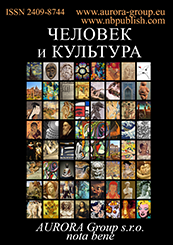Gender studies
Reference:
Liu, T. (2025). Appealing and Responding: An Interpretation of the Confucian Canon "Li Ji" from the Perspective of Modern Feminist Critique. Man and Culture, 3, 1–13. https://doi.org/10.25136/2409-8744.2025.3.74307
Abstract:
The subject of this research is a critical analysis of the Confucian canon "Li Ji" from a feminist perspective, grounded in the philosophy of Emmanuel Levinas. The study focuses on the ethical status of women within the Confucian ritual-moral system and reveals how female subjectivity is structurally excluded from the realm of ethical expression. Attention is given to both the textual mechanisms that reinforce gender otherness and the forms of female response, which are simultaneously imbued with emotionality and normative discipline. Using Levinas's concept of the Other, the work aims to show that women in "Li Ji" function as ethical carriers but not as recognized subjects capable of calling to account. Thus, the research contributes to understanding the possibility of the female voice as the beginning of ethical relations within the patriarchal canon. The study employs a comparative philosophical method, combining a critical reading of the Confucian text with feminist analysis and the conceptual apparatus of Levinas's ethics to reveal gender asymmetries in the structure of moral recognition. The scientific novelty of the research lies in the interdisciplinary interpretation of the Confucian canon "Li Ji" at the intersection of feminist critique and the ethical philosophy of Emmanuel Levinas. The main methods used include hermeneutic analysis, intertextual approaches, and critical-discursive readings of key concepts such as "ritual," "obedience," and "difference." The study shows that despite women's active participation in ritual-ethical practice, their status as a Person remains invisible and unrecognized within the moral structure. The work demonstrates how the normative logic of the text generates an effect of ethical silence, structurally placing women in the position of the responding subject while excluding them from the possibility of being initiators of moral calls. This gender bias in the Confucian model necessitates philosophical deconstruction. In conclusion, the necessity to rethink the very foundation of ethical relations and affirm the female voice as an equal and autonomous source of ethical subjectivity and moral expression is emphasized.
Keywords:
Ethics and Gender, Structural inequality, Gender norms, Confucian family ethics, Gendered othering, Levinas, Face, Affective labor, Confucian ritual, Female subjectivity
Art and Art History
Reference:
Mezhinskaya, V.R. (2025). The urban landscape of St. Petersburg by artists of the academic school of the 2000s and 2020s. Man and Culture, 3, 14–26. https://doi.org/10.25136/2409-8744.2025.3.74448
Abstract:
The article reveals the theme of the "urban landscape", formulates the main features, using the example of the works of artists. There are not many images in modern academic painting that harmoniously combine genre subjects and urban views. Among the graduates of the St. Petersburg Academy of Arts, there are artists who are fascinated by the "living" aspects of the urban environment: A. Gorlanov, K. Malkov, as well as P. Tyutrin, A. Makarov, I. Tupeyko find inspiration in everything they see around them (in passers-by on the streets, in festive events in squares and boulevards). The subtlety of the artists' perception is focused on interesting details and plot. In the works of these landscape painters, the everyday life of the Northern Capital is perceived as an endlessly changing motif. The subject of the study is the urban landscape of St. Petersburg. Research methods such as cultural and historical analysis and formal stylistic analysis are used to study this topic. The study is due to the low degree of study of the modern St. Petersburg urban landscape in the scientific and theoretical field of art criticism. The urban landscape expertly balances between two principles of depicting reality: natural, realistic, and conventional, decorative. In modern academic painting in the genre of urban landscape, various human interactions with the urban environment are shown: images can convey an organic existence in the dynamics of the strict geometry of the city, loneliness and isolation, and the contrast between history and modernity. In the practice of modern academic art, new approaches to landscape largely synthesize genre forms familiar to the viewer. Landscape images can be present in portraits, still lifes, and everyday scenes where nature or an urban backdrop serve to create a certain mood, symbolism, or compositional solution. The urban landscape occupies a significant place in modern academic painting, as it allows artists to convey the dynamics of urban life and its internal contradictions.
Keywords:
St. Petersburg, Academy of Arts, academic painting, modern landscape, landscape genre, St. Petersburg landscape, landscape painting, painting, modern art, urban landscape
Music and music culture
Reference:
ZHOU , Z. (2025). The contribution of the Moscow State Conservatory named after P.I. Tchaikovsky to the establishment of the Chinese school of choral conducting. Man and Culture, 3, 27–37. https://doi.org/10.25136/2409-8744.2025.3.74727
Abstract:
The subject of this study is the art of choral conducting as one of the most relevant aspects of contemporary musical culture in China. The object of the research is the examination of the creative and pedagogical methods employed by the faculty of the Moscow Conservatory with Chinese students who are choral conductors. The aim of this article is to explore the pathways of forming the profession of choral conductor in China and to determine the role of the Moscow Conservatory in this process. The author examines various aspects of the topic, such as the cultural interaction between the USSR and the PRC in the 20th and 21st centuries, tracing the history of the influence of Russia’s largest music institution on the establishment of a choral conducting school in China. A number of key figures among Soviet and Russian musicians who made significant contributions to this process are identified. The author notes that choral education in Russia is characterized by philosophical-aesthetic depth, semantic concentration, and technical sophistication. The methodology consists of a synthesis of historical-theoretical and choral studies methods. Based on this, the history of training Chinese students at the Moscow Conservatory is revealed. Special attention is given to the independent performing and pedagogical activities of prominent choral conductors in China. The research experience aims to establish connections between the Russian school of choral conducting and the development of contemporary Chinese choral art. The main conclusion of the conducted research is the paradigm of profound mutual influence and enrichment in the musical arts of Russia and China. In particular, this position has become a determining factor in the musical education of Chinese students at the Moscow Conservatory. A significant contribution of the author to the topic is the study of the current state of the educational process for students from China in the choral conducting department at the Moscow Conservatory, which has not previously been the object of special research. The novelty of the study lies in the fact that it presents materials on the education of currently prominent choral figures in China: Wu Lingfeng, Yan Liankun, Cao Tongyi, Wang Chao. Attention is drawn to the need to study the historical aspects of the establishment of the national school of choral conducting in China, linked to the traditional musical thinking of China and the shift towards the assimilation of the Russian conducting and choral tradition.
Keywords:
Cao Tongyi, Wu Linfeng, Yan Liankun, choral performance, choral music, Chinese music, conducting, choir, Moscow Conservatory, Wang Chao
Theoretical culturology and the theory of culture
Reference:
Viktorova, E.V. (2025). Conceptual and theoretical prerequisites for considering impressing as a socio-cultural phenomenon. Man and Culture, 3, 38–50. https://doi.org/10.25136/2409-8744.2025.3.71101
Abstract:
The object of the study is an impressing phenomenon with a complex biosociocultural nature. References to it in the scientific literature, given its "closely related" relationship with imprinting, primarily evoke associations with its biological nature. However, attention is drawn to the recent growing interest in imprinting / impressing representatives of a wide range of social sciences and humanities. The shift of emphasis in the biosociocultural nature of impressing from its bio-component to the socio-cultural one becomes obvious and necessary. However, the emergence of the concept of "imprinting/ impressing" beyond the limits of natural science knowledge, as a rule, is not accompanied by any reflection on the conceptual and theoretical grounds for considering the phenomenon behind it in the social subject field. Accordingly, the subject of the presented research is the conceptual and theoretical prerequisites for considering impressing as a socio-cultural phenomenon. Modern scientific ideas about the complex unity of nature, society, culture and the place of man in it, which can serve as a theoretical basis for socio-cultural research of impressing, are analyzed and synthesized. Deductive, axiomatic methods and the method of analogy are used in the development of the conceptual foundations of the study of impressing, based on the specifics of modern socio-cultural knowledge. The main results of the work include, firstly, the identified trends in modern knowledge about culture and the person in it, which allow us to assert that the socio-cultural analysis of impressing has theoretical and methodological grounds. The key of the described trends is the idea of a multifaceted and unstable interpenetration of the natural principle, sociality and culture. Special emphasis is placed on the tendency to consider culture as a product of the psyche and the human psyche as a natural and cultural phenomenon. Secondly, based on the trends identified in modern socio-cultural knowledge, and by analogy with them, the conceptual foundations for considering impressing as a complex biosociocultural phenomenon in the functioning of which the socio-cultural component plays a key role are proposed. Conclusions are drawn about the directions of further study of impressing, which is supposed to be debatable, but necessary. The consideration of the conceptual foundations of the study of impressing as a socio-cultural phenomenon seems to be new and theoretically significant for the socio-humanitarian sciences as a whole, since it opens up the possibility of a more fruitful multidimensional understanding of the little-studied phenomenon.
Keywords:
an active person, sociocultural trends, culture and psyche, imprinting, impressing, information impact, a man in culture, sociocultural knowledge, creative potential, self-organization of culture
Culture and authority
Reference:
Lenchuk, V.Y. (2025). Sicily between eras: from the power of Sextus Pompey to the reorganization of Augustus. Man and Culture, 3, 51–61. https://doi.org/10.25136/2409-8744.2025.3.74601
Abstract:
The subject of this research is the historical process of the transformation of Sicily at the end of the 1st century BC, covering the period of Sextus Pompey’s rule and the subsequent administrative reorganization carried out by Octavian Augustus. The article examines the consequences of the civil wars of the Roman Republic for the socio-economic situation of the island, including the destruction of cities, the decline of agriculture, and the demographic crisis. The measures taken by Octavian after the defeat of Sextus Pompey are analyzed, including the confiscation of property, the deportation of opponents, the establishment of Roman colonies, changes in the tax system, as well as social and administrative reforms. The study aims to identify the patterns of Sicily’s transition from a state of political and economic decline to integration into the administrative system of the Roman Empire, taking into account cultural and economic aspects. The methodological framework of the research includes the analysis of ancient written sources, archaeological data, a comparative analysis of literature, as well as historical-systems and structural-functional approaches to identify the patterns of Sicily's transitional period from republican to imperial governance. The scientific novelty of the research lies in the fact that for the first time in domestic historiography, a comprehensive analysis of the transitional period in the history of Sicily is conducted, when the rule of Sextus Pompey was replaced by the administrative reorganization carried out by Octavian Augustus. The interconnections between political instability, economic decline, and rehabilitative reforms are traced in detail, as well as the scale of the impact of these reforms on the socio-economic and cultural structure of the island is assessed. The work demonstrates that Augustus's punitive measures were combined with a colonization program, the introduction of fixed taxes, and infrastructure restoration, which allowed Sicily to recover and integrate into the administrative system of the Roman Empire. Special attention is given to the combination of repressive and constructive measures in stabilizing the region, ensuring its long-term sustainability, and forming a new social base.
Keywords:
Octavian Augustus, administrative reorganization, archaeology, taxation system, colonization, civil wars, Roman Republic, reforms, Sextus Pompey, Sicily
 This work is licensed under a Creative Commons Attribution-NonCommercial 4.0 International License.
This work is licensed under a Creative Commons Attribution-NonCommercial 4.0 International License.
 Eng
Eng











 © 1998 – 2025 Nota Bene. Publishing Technologies. NB-Media Ltd.
© 1998 – 2025 Nota Bene. Publishing Technologies. NB-Media Ltd.




